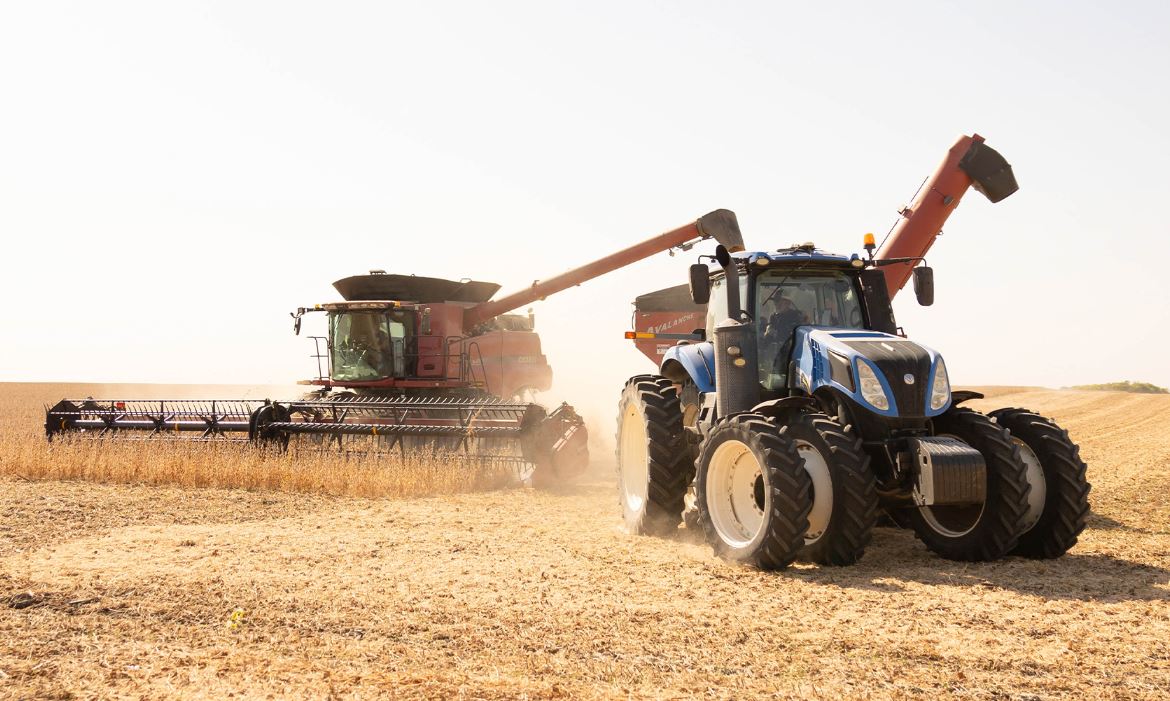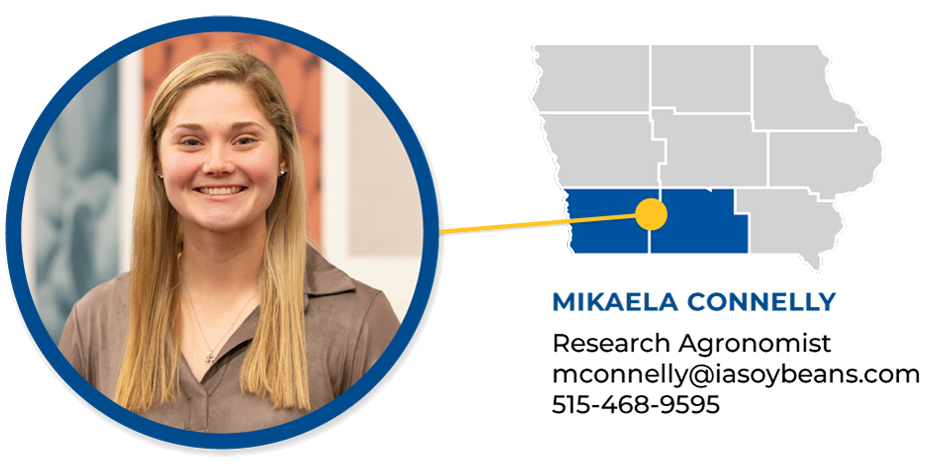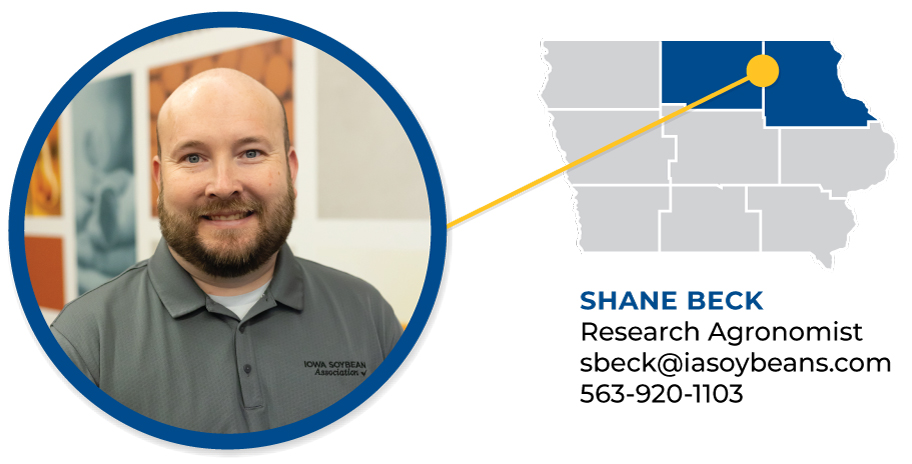
(Photo: Iowa Soybean Association / Joclyn Bushman)
Walking Rows: ISA agronomists update – November 7
November 7, 2024 | Kriss Nelson
The 2025 growing season did not come without its challenges. From a wet spring to a dry summer, Mother Nature kept farmers and agronomists on their toes.
In this last edition of Walking Rows, Iowa Soybean Association (ISA) research agronomists reflect on 2024 and look forward to 2025.
Alex Schaffer – Central Iowa
What surprised me the most from this growing season was the difference in how the season started versus how it finished. After planting we were asked about the attitudes of farmers and what we thought the crop would be like. My first thought was that the top end was taken out due to some heavy rains, cool soils after planting, ponding and saturated soils. I thought that would put a big dent in field averages compared to the last few years when emergence seemed to go a little better. I was very surprised to hear this fall, some soybean farmers achieved field averages near 80 bushels to the acre and corn field averages in the mid-230s to 240 bushels to the acre and above. Keep in mind these are field averages.
So, I’ve been asking farmers after harvest if they feel like they were able to “bushel out” of poor commodity prices. Most of them don’t answer the question directly but seem satisfied with their harvest despite the low market prices.
The season seemed to be shaping up to be a big fungicide year due to the wet weather early, but after a lot of product was applied across the state, it turned dry in August and September. There was not a long enough period of late morning dews and rainy days or nights to really drive disease development.
In hindsight, I would not have applied fungicide on soybeans this year. We haven’t analyzed our trial data yet, but my scouting trips, at least in District 5, showed little to no disease pressure at the R5 growth stage

My advice on soybean fungicide after the past two years of trials would be not to pre-book any product and make that decision based on current and forecasted conditions in late July/early August.
ILeVO seed treatment seemed to pay off this year. Given the rainy early season, the potential for sudden death syndrome (SDS) was high. We saw SDS widespread in a couple of untreated fields and randomly infected plants here or there in fields planted with ILeVO-treated soybean seed. This is another hard one to say if it will pay every year because the disease is so weather-dependent, but I would have to suggest at least having some of your beans treated and then plan on planting those in the early part of the planting season and spreading your risk.
If I had a crystal ball one year ago today, I would be telling farmers not to put all of their nitrogen on this fall, and what they put on should include a stabilizer.
Nitrification continued to happen in the soil throughout a good portion of the winter of 23/24 due to mild conditions. That, followed by heavy rains in the early season, washed a lot of nitrate nitrogen out of the root zone, making it unavailable for crop uptake. We just analyzed a nitrogen stabilizer trial (strips with and without N-Serve) where the plots with stabilizer outyielded those areas without stabilizer by 18 bushels.
Weather conditions play a huge role in the need for a nitrogen stabilizer. Still, the conservationist in me says to include it in the fall, and the agronomist in me says save as much nitrogen application for as close to when the crop needs it (side-dress) as you can tolerate logistically.
I encourage farmers to reach out for on-farm trial opportunities and tell me what they learned this season and how they will improve efficiency in their operations.
Mikaela Connelly – Southwest/Western Iowa
Overall, the season went well for most southwest and south-central Iowa growers. Even though the wet spring caused some adverse conditions, it seems to have wrapped up nicely.
Some corn fields still need to be harvested, but hopefully, harvest season will wrap up soon. If harvest is over for you and your operation, I think now is the best time to assess how the season went.
The first thing to reflect on is your operation's planting date and evaluate how that went this year. Did you try early planted beans this year? Were the seeds sitting underwater for a while, and did this cause fields to be replanted? Was there some early disease due to the moisture and temperatures? Did you try a different population compared to other years?
The answers and potential benefits from these questions will vary from operation to operation, but I believe they are good questions to ponder.

Now that we have received some moisture, I think a consideration for growers planning for fall anhydrous would be either using a nitrogen inhibitor or potentially split-applying nitrogen. With the excess moisture this spring, some nitrogen-deficient corn due to leaching might have caused more nitrogen to be applied than initially planned.
Did this work to your operation's favor? Nutrient applications have to be done in a way that works best for you and your operation, but they can also be key points of reflection.
If you want to find your operation's agronomic and economic optimum by comparing five nitrogen rates, contact an ISA research agronomist to see if our Nitrogen Initiative trial is a good fit for you.
With how humid and wet the summer was, there could have been increased disease and pest pressure. Was fungicide applied to your acres? What product was used, and was there any influence?
Our fungicide trial results, which will be posted on our website, could be a resource to compare different products and see if one product stood out over the rest.
Fundamental topics, such as soil fertility, are vital for a successful growing season and ideal yield, so consider soil sampling your fields this fall to see your nutrient levels.
Joe McClure, ISA director of research, provided more details in the September edition of the Iowa Soybean Review in his column, "A Case for Soil Sampling."
This spring, we will have a variety of trials available, including a seeding rate decision trial.
The seeding rate decision trial involves comparing four seeding rates, which are 80k, 110k, 140k, and 170k, and comparing the stand counts and yield across the different seeding rates. Feel free to contact me or other research agronomists to discuss any questions about various agronomic topics or trial opportunities.
Lucas DeBruin - Southeast/Eastern Iowa
On the whole, I'm satisfied with the season, considering it had a bit of a rough start to it. Despite the wet spring and dry summer, crops yielded very well.
The planting date definitely had an impact on yields. If you were able to get crops planted in early April, you seemed to be rewarded, especially on beans. Despite later plantings, corn yields remained strong. If I could go back to the beginning of April with my current knowledge, I would have told everyone to plant when they questioned it during the first early window.

If you did any in-season nitrogen, you got rewarded. Fall NH3 only showed its ugly side this year.
Looking forward, the best input prices will generally be the best the first time they come out; in some years, there are exceptions. With tight margins, it is important to ensure you utilize every dollar you can. Look at how many bushels it costs instead of just the price per ton or gallon. It’s a great time to work with ISA to conduct trials and verify the ROI on your farm.
Shane Beck – Northeast/Northern Iowa
This year, I observed that multiple nitrogen applications were helpful. The one-pass anhydrous systems struggled this year due to the warm winter and wet spring.
This year, a nitrogen stabilizer was key for those early anhydrous applications. Our trials show nitrogen stabilizer increased yield by 10-20 bushels per acre.
We're investigating micronutrients based on farmer trial results. Yield differences are evident in some but not in many. In some cases, sulfur showed a yield increase; however, this happened in fields with a sulfur deficiency. Sulfur application was ineffective in fields without sulfur deficiencies.

We'll keep researching foliar-applied micronutrients despite limited success from other applications this year.
I encourage farmers to soil sample to better understand their soil’s nutrient levels and correct anything that could be deficient – whether that is soil or foliar applied to help increase yield.
Now that we have received some rain, cover crops are beginning to take off, and I am hopeful they will get some good growth in before they go dormant for the year. They should be able to protect the soil and scavenge for any nutrients left out in the field.
This fall, ISA is conducting trials on bio-stimulant applications to break down cornstalks. For this trial, we will be sampling multiple times to see how cornstalks break down throughout the year and end with yield data after soybeans are harvested. We will also be looking into claims the breakdown of the residue releases nutrients; we will be researching that aspect to see if those claims are true and if a farmer will be able to reduce fertilizer application by using a bio-stimulant to break down residue.
Back